The fascinating world of geckos offers an extraordinary palette of colors and patterns that can transform any terrarium into a vibrant, living art piece. These charismatic reptiles have become increasingly popular as pets due to their manageable size, relatively simple care requirements, and most notably, their stunning visual appeal. From the electric blues of day geckos to the fiery oranges of crested species, colorful geckos bring both beauty and personality to the homes of reptile enthusiasts. For those looking to add some natural color to their living space, these scaled companions provide an engaging alternative to traditional pets while requiring less daily maintenance than many mammals. Let’s explore some of the most visually striking gecko species that not only catch the eye but also make wonderful companions for both novice and experienced reptile keepers.
Leopard Geckos (Eublepharis macularius)
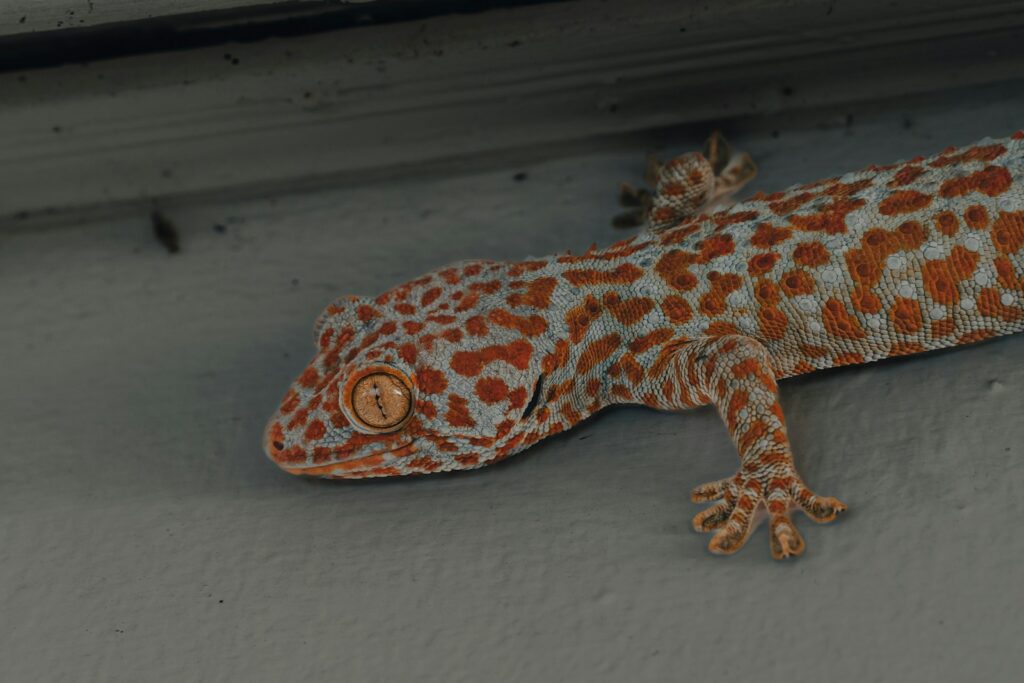
While classic leopard geckos display a yellow base with black spots, selective breeding has produced a rainbow of morphs that make them among the most colorful pet reptiles available. Vibrant tangerine leopard geckos showcase warm orange tones across their bodies, while lavender varieties exhibit subtle purple hues that shimmer under proper lighting. The highly sought-after “RAPTOR” (Red-Eyed Albino Patternless Tremper Orange) morph features striking solid orange bodies paired with ruby-red eyes that create a dramatic appearance. Beyond their diverse coloration, leopard geckos remain one of the most beginner-friendly reptiles, with docile temperaments, manageable sizes reaching 8-10 inches, and lifespans of 15-20 years with proper care. Their ground-dwelling nature means they don’t require complex vertical habitats, making them an accessible option for those new to gecko keeping.
Crested Geckos (Correlophus ciliatus)
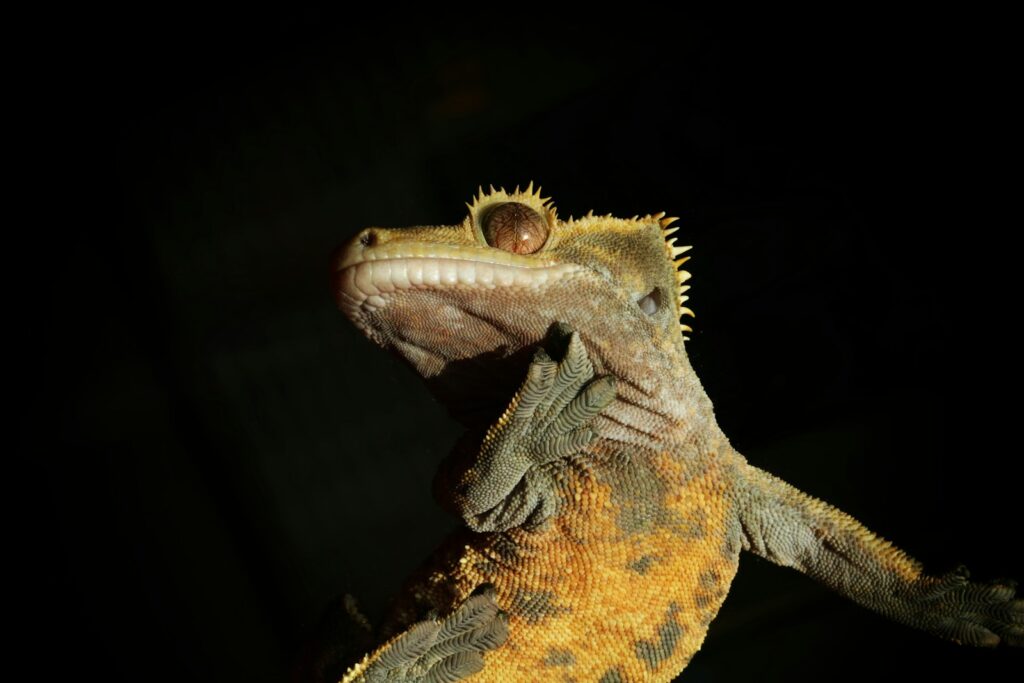
Crested geckos have surged in popularity partly due to their incredible color diversity, ranging from deep reds and oranges to creams, yellows, and even near-black specimens. Their most distinctive physical feature—the crest of soft, spiky scales running from their eyes to tail—can display contrasting colors that accentuate their overall appearance. The “harlequin” pattern, featuring bold patches of contrasting colors, and the “flame” pattern, with color rising up from the base like fire, are particularly prized by enthusiasts for their dramatic visual impact. Unlike many reptiles that require UVB lighting, crested geckos thrive without special lighting setups, making them more economical and straightforward to maintain. Their fruit-based diet requirements, supplemented with commercially available powdered foods, simplify feeding routines compared to insect-dependent species. Additionally, their calm demeanor and tolerance for gentle handling make them excellent display pets that can also form bonds with careful owners.
Day Geckos (Phelsuma species)

Few geckos can rival the electric brilliance of day geckos, particularly the Giant Day Gecko (Phelsuma grandis) with its neon green body accented by vibrant red spots and blue eye rings. These diurnal (day-active) geckos showcase their colors most vividly during the daytime, providing more visual enjoyment than nocturnal species that hide during human waking hours. The Peacock Day Gecko (Phelsuma quadriocellata) displays beautiful blue spots on its back that resemble peacock eyespots, creating a truly unique appearance unlike any other reptile pet. While not ideal for handling due to their delicate skin and quick movements, day geckos compensate with active, observable behaviors that make them fascinating terrarium subjects to watch as they explore, hunt, and interact with their environment. Their vertical orientation requires taller terrariums with plenty of climbing surfaces, which creates opportunities for visually striking planted setups that can serve as living centerpieces in any home.
Gargoyle Geckos (Rhacodactylus auriculatus)
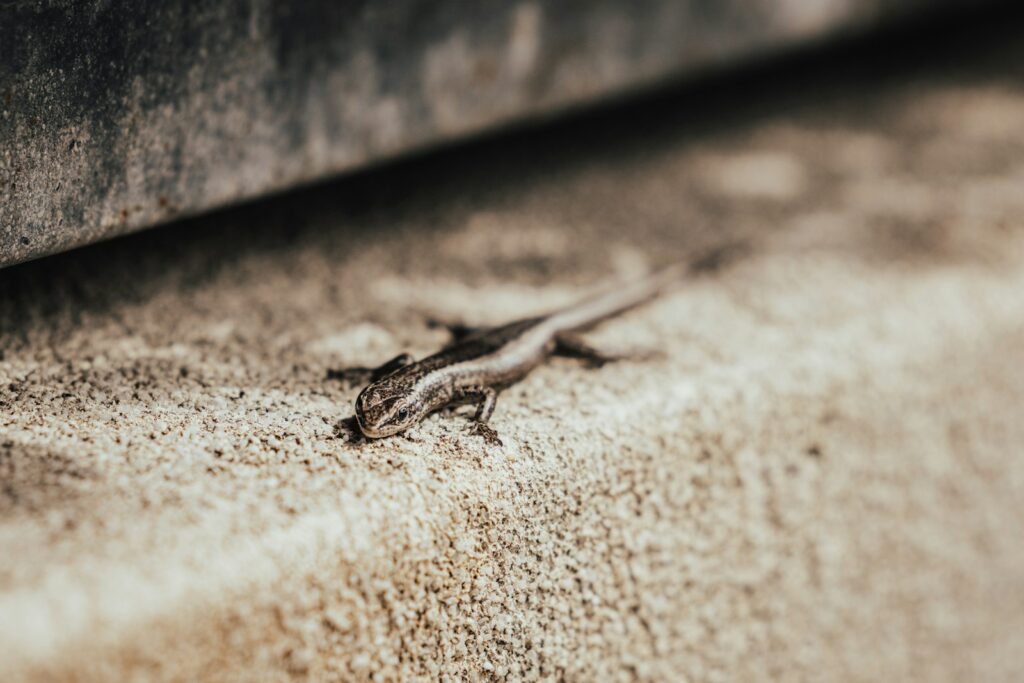
Gargoyle geckos offer an impressive range of colors including reds, oranges, yellows, whites, and various patterns that make each individual truly unique. The “red stripe” morph features a bold crimson line running down the back against a contrasting base color, creating a dramatic visual effect that stands out even in dimly lit environments. These geckos earn their name from the distinctive knobs and ridges on their heads that resemble miniature gargoyles, adding character beyond just their coloration. Their robust build and relatively slow movements make them easier to handle than many other gecko species, though they still require gentle and respectful interaction. Like their close relatives, the crested geckos, gargoyles thrive on commercially available powdered diets supplemented with occasional insects, simplifying their care routine while ensuring proper nutrition. Their moderate adult size of 7-9 inches makes them substantial enough to observe and appreciate without requiring excessive space or specialized equipment.
Tokay Geckos (Gekko gecko)
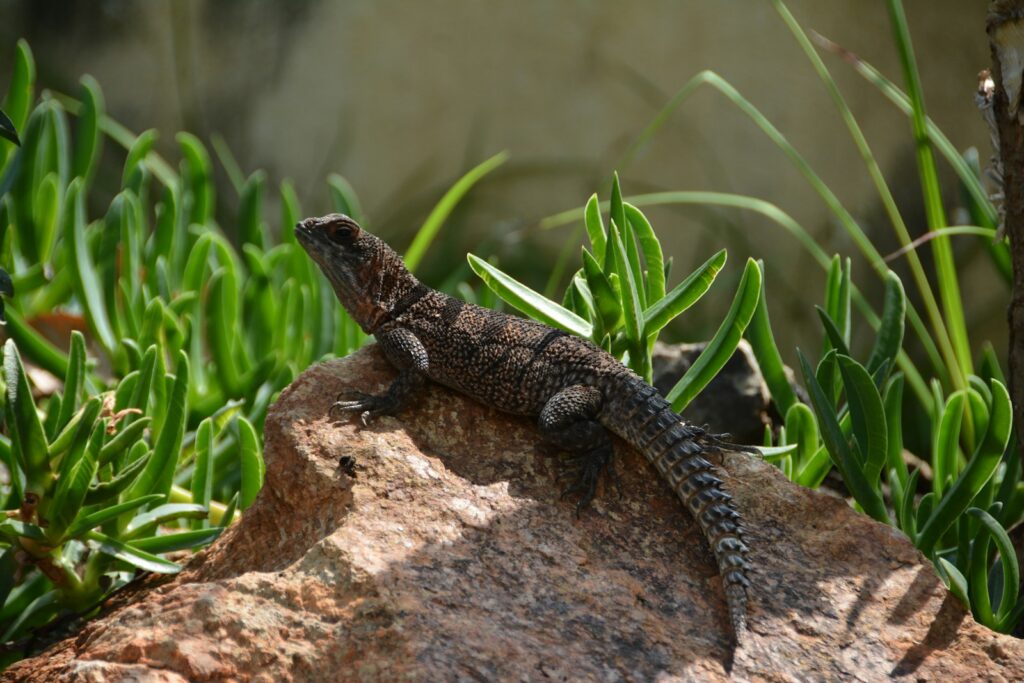
The Tokay gecko presents one of nature’s most vibrant displays with a base color ranging from bright blue to gray, overlaid with orange or red spots that create a speckled, almost polka-dot appearance. During breeding season, males develop particularly intense coloration, with their blue tones becoming electric and their spots glowing like embers against the cooler background. Despite their stunning appearance, Tokays have earned a reputation for their assertive temperament, making them better suited for experienced keepers who appreciate their beauty from a respectful distance. Their distinctive vocalizations—the “to-kay” call that gave them their name—adds an auditory dimension to keeping these geckos that most other species don’t offer. With proper enclosure design featuring vertical space and numerous hiding spots, these larger geckos (reaching 10-15 inches) can thrive for 10+ years, rewarding patient keepers with their unmistakable presence and remarkable coloration.
African Fat-Tailed Geckos (Hemitheconyx caudicinctus)

While more subtly colored than some species, selective breeding has produced African fat-tailed geckos with rich orange, red, and even lavender hues that develop more intense coloration as they mature. The “oreo” morph displays striking black and white contrast reminiscent of the famous cookie, while “white-out” specimens showcase a ghostly pale appearance with minimal patterns. Their most distinctive feature—the thick, fat-storing tail that gives them their name—often displays different coloration than the body, creating a two-toned effect that adds visual interest. African fat-tails share many care requirements with leopard geckos but originate from more humid environments, making them suitable for keepers in naturally humid climates. Their generally calm temperament and slow, deliberate movements make them excellent candidates for careful handling, allowing owners to appreciate their subtle coloration up close. Additionally, their ground-dwelling nature means they don’t require tall, complex enclosures, making them practical pets for those with limited space.
Gold Dust Day Geckos (Phelsuma laticauda)
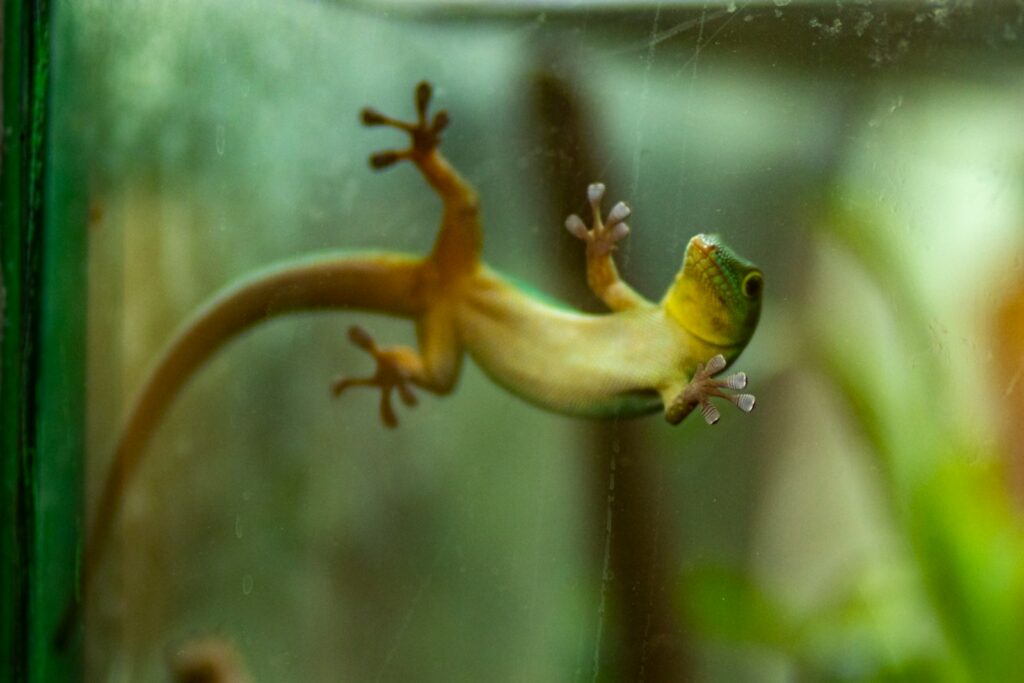
True to their name, Gold Dust Day Geckos appear as though they’ve been sprinkled with flecks of metallic gold across their vibrant green bodies. Red markings on their faces and backs provide striking contrast to their emerald base color, creating a festive appearance reminiscent of holiday decorations. Despite their small size (reaching only 4-5 inches), these geckos make their presence known with bold coloration and active daytime behavior that allows owners to observe their natural activities. Their compact dimensions make them ideal for smaller, well-planted terrariums that can fit in apartments or limited spaces where larger reptile setups wouldn’t be practical. While they move too quickly for regular handling, their tiny toe pads allow them to scale glass and other smooth surfaces, creating entertaining displays as they navigate their environment with remarkable agility. Their fruit-based diet requirements, supplemented with small insects, make them relatively straightforward to maintain for keepers willing to provide appropriate humidity and temperature gradients.
Chahoua Geckos (Correlophus chahoua)

Sometimes called the “mossy prehensile-tailed gecko,” Chahoua geckos display extraordinary color variance ranging from deep reds and chocolates to mossy greens that provide natural camouflage in their native habitat. Their ability to change color intensity based on temperature, mood, and time of day means their appearance can shift dramatically, providing an ever-changing display that keeps owners engaged. The texture of their skin—covered in small, raised tubercles—catches light in fascinating ways that add dimension to their already impressive coloration. Their prehensile tails serve as functional fifth limbs, allowing them to secure themselves to branches while reaching for food or exploring, creating distinctive postures rarely seen in other pet reptiles. Though less common in the pet trade than some others on this list, Chahouas have developed a dedicated following among experienced keepers who appreciate their unique appearance and interactive personalities. Their care requirements mirror those of crested geckos, making them suitable for keepers who have mastered the basics and are looking for something more unusual.
Lined Day Geckos (Phelsuma lineata)

The Lined Day Gecko presents a vivid lime-green base color accented by striking red dorsal stripes that run from nose to tail, creating one of the most well-defined patterns in the gecko world. Blue speckling around their eyes and lower jaw areas adds further color complexity that reveals itself upon closer inspection. Some specimens develop an almost turquoise hue along their sides, creating a gradient effect that transitions between their primary colors. These medium-sized day geckos (6-7 inches) provide the visual impact of larger species while requiring less space, making them suitable for keepers with moderate-sized terrariums. Their tendency to bask prominently on vertical surfaces during daylight hours ensures they’ll be visible for observation rather than hiding away like many nocturnal species. While they require more specialized care than beginner species—including higher humidity, UVB lighting, and carefully controlled temperatures—the reward is a living jewel that brings tropical color to any collection.
Satanic Leaf-Tailed Geckos (Uroplatus phantasticus)
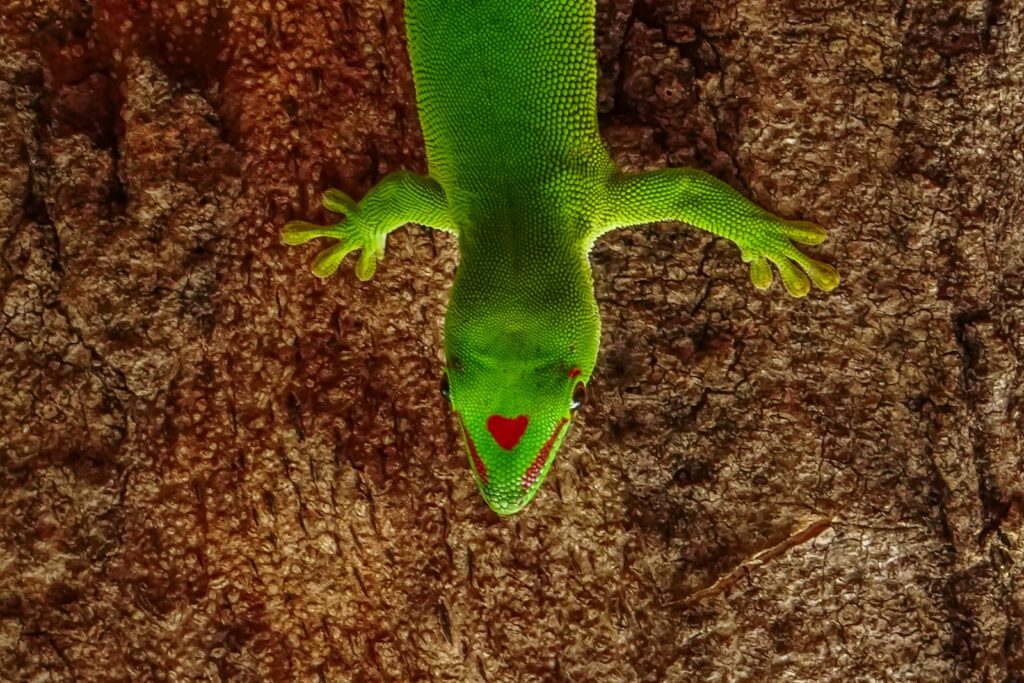
Despite their ominous name, Satanic Leaf-Tailed Geckos offer some of the most variable and unusual coloration in the gecko world, ranging from rich browns and russets to mossy greens and even purplish tones. Their most remarkable feature—a leaf-shaped tail that perfectly mimics dead or decaying foliage—often displays different coloration than the body, creating a compelling dual-tone effect. The irregular edges, veining, and occasional “damaged” areas of their tails represent one of nature’s most perfect camouflage adaptations, making each individual visually unique. While primarily kept by advanced keepers due to their specialized care requirements, these geckos reward dedicated owners with an appearance so unusual that guests often mistake them for model reptiles rather than living creatures. Their relatively small size (4-5 inches) belies their outsized visual impact, allowing them to make a dramatic statement in carefully designed bioactive terrariums that showcase their remarkable evolutionary adaptations.
White-Spotted Gecko (Tarentola annularis)
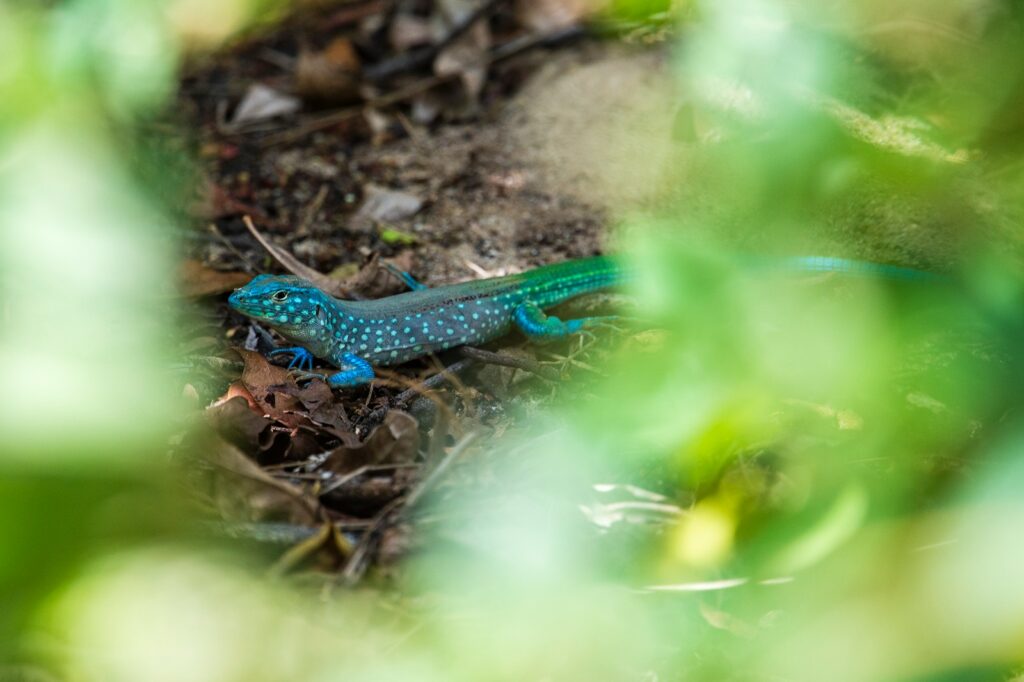
The White-Spotted Gecko presents a dramatic appearance with its dark gray to nearly black base color illuminated by brilliant white spots that seem to glow against the darker background. During periods of excitement or stress, these geckos can darken their base color further, causing their spots to stand out even more dramatically in a display that few other reptiles can match. Their relatively large size (up to 8 inches) and robust build give them a substantial presence in terrariums, making them visible even from across a room. Unlike many colorful species that require tropical conditions, White-Spotted Geckos tolerate more arid environments, making them suitable for keepers who struggle to maintain high humidity levels. Their fascinating vocalization repertoire includes chirps, barks, and clicks that add an auditory dimension to keeping these visually striking reptiles. Though less common in the pet trade than some other species, their growing popularity reflects their unique appearance and moderate care requirements.
Setting Up the Perfect Habitat for Colorful Geckos
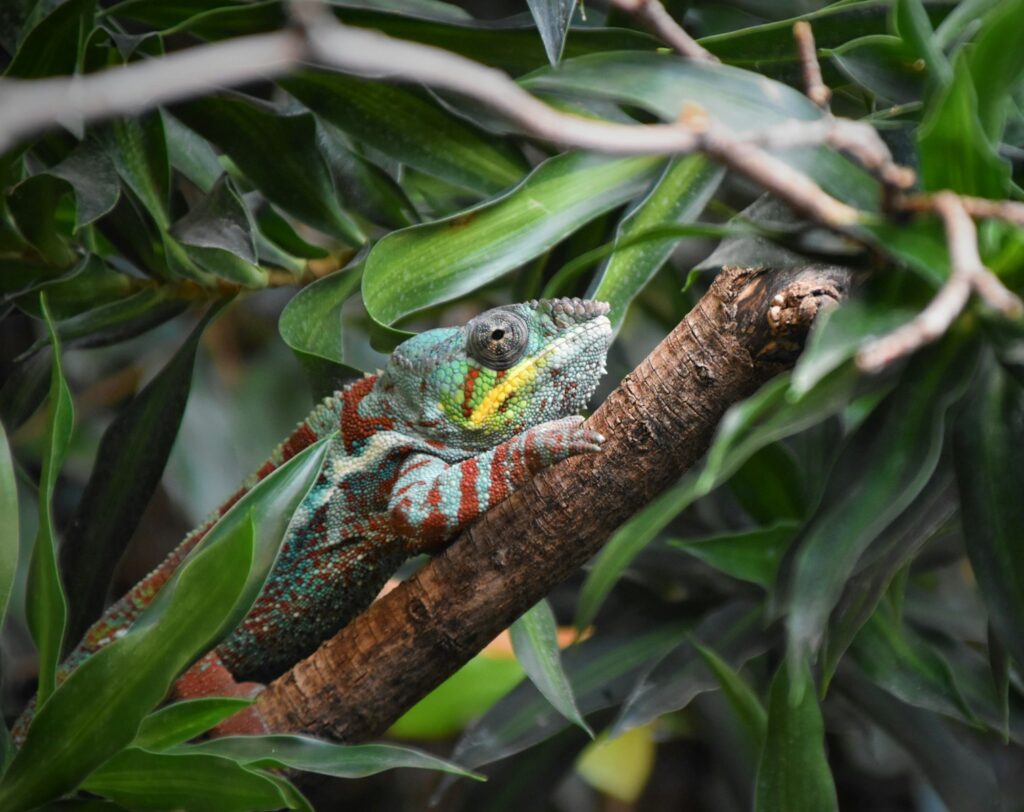
Creating an environment that not only meets your gecko’s needs but also showcases their vibrant colors requires careful consideration of lighting, which should include UVB for day-active species and gentle ambient lighting for displaying nocturnal species during evening viewing hours. Background and substrate choices significantly impact how your gecko’s colors appear—darker backgrounds often make colors pop, while naturalistic backgrounds can create a more immersive viewing experience that highlights your pet in a context similar to their native habitat. Live plants not only provide environmental enrichment and humidity regulation but also create natural color contrasts that enhance your gecko’s appearance through complementary green tones. Temperature gradients are essential for proper health and often influence coloration, as many species display their most vibrant hues when maintained at optimal temperatures with appropriate basking spots. Proper humidity levels maintained through misting systems or manual spraying not only support health but also create opportunities to observe behaviors like water droplet drinking, during which many species display their full color spectrum as they move through their environment.
Feeding and Nutrition for Vibrant Coloration
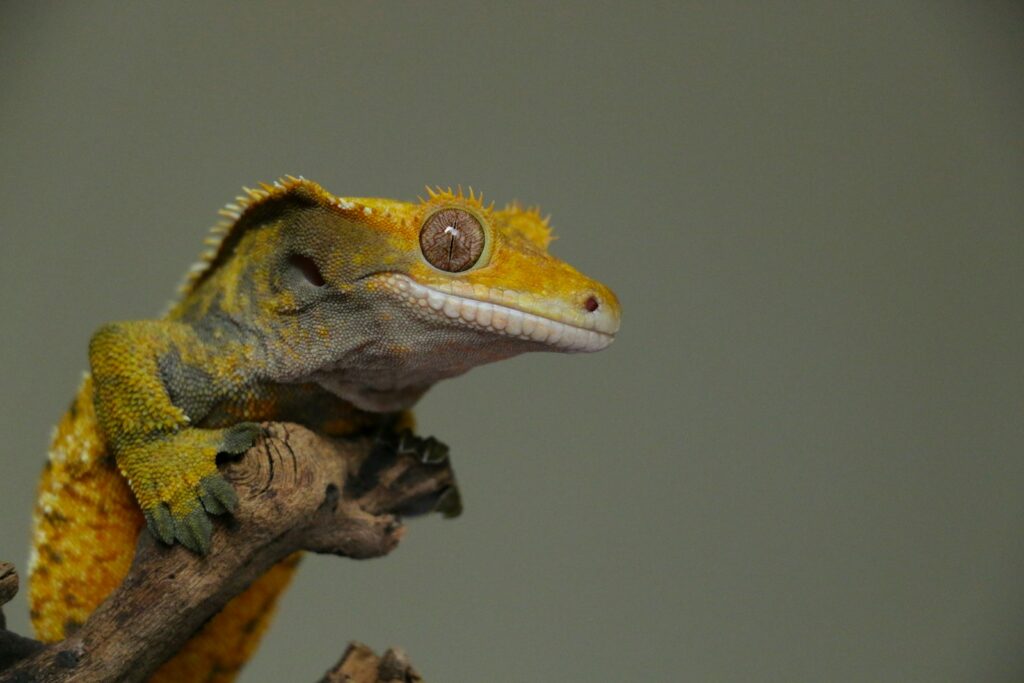
The brilliance of your gecko’s colors depends significantly on their diet, with carotenoid-rich foods like appropriately gut-loaded insects helping to enhance reds, oranges, and yellows in many species. Commercial diets formulated specifically for fruit-eating geckos contain color-enhancing nutrients that support vibrant appearance while ensuring proper nutrition for species like crested geckos and day geckos. Regular supplementation with calcium and vitamins is crucial not just for health but also for optimal coloration, as nutrient deficiencies often manifest as dulling or uneven color development before other symptoms appear. Hydration plays a vital but often overlooked role in color expression, with well-hydrated geckos typically displaying more vibrant, saturated colors than those suffering from even mild dehydration. Feeding schedules should be tailored to each species’ natural patterns, with appropriate portion sizes to prevent obesity which can diminish a gecko’s natural coloration by stretching skin and altering fat distribution. Variety in prey items or prepared diets ensures your gecko receives the full spectrum of nutrients needed to maintain their genetic color potential throughout their lifespan.
Conclusion
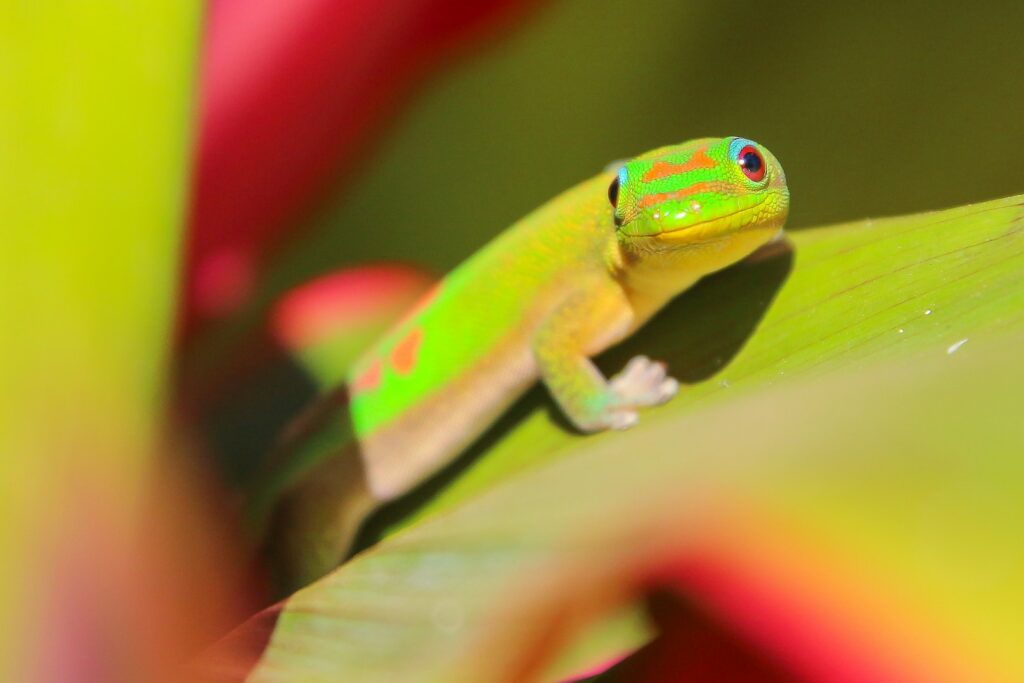
Colorful geckos represent nature’s artistry in reptile form, bringing vibrant hues and fascinating patterns into our homes as manageable, engaging pets. From the beginner-friendly leopard gecko with its ever-expanding palette of morphs to the electric brilliance of day geckos, these reptiles offer visual rewards that few other pets can match. While each species requires specific care tailored to their evolutionary adaptations, most colorful geckos thrive in properly maintained captive environments, often displaying their most vibrant colors when their needs are fully met. Whether you’re drawn to the bold spots of a Tokay, the fiery orange of a crested gecko, or the metallic flecks of a Gold Dust Day Gecko, these remarkable reptiles invite us to appreciate the diversity of color that evolution has produced. As responsible keepers continue to refine husbandry practices and breeding programs, we can look forward to even more stunning gecko varieties while honoring the natural beauty that makes these scaled companions so special.

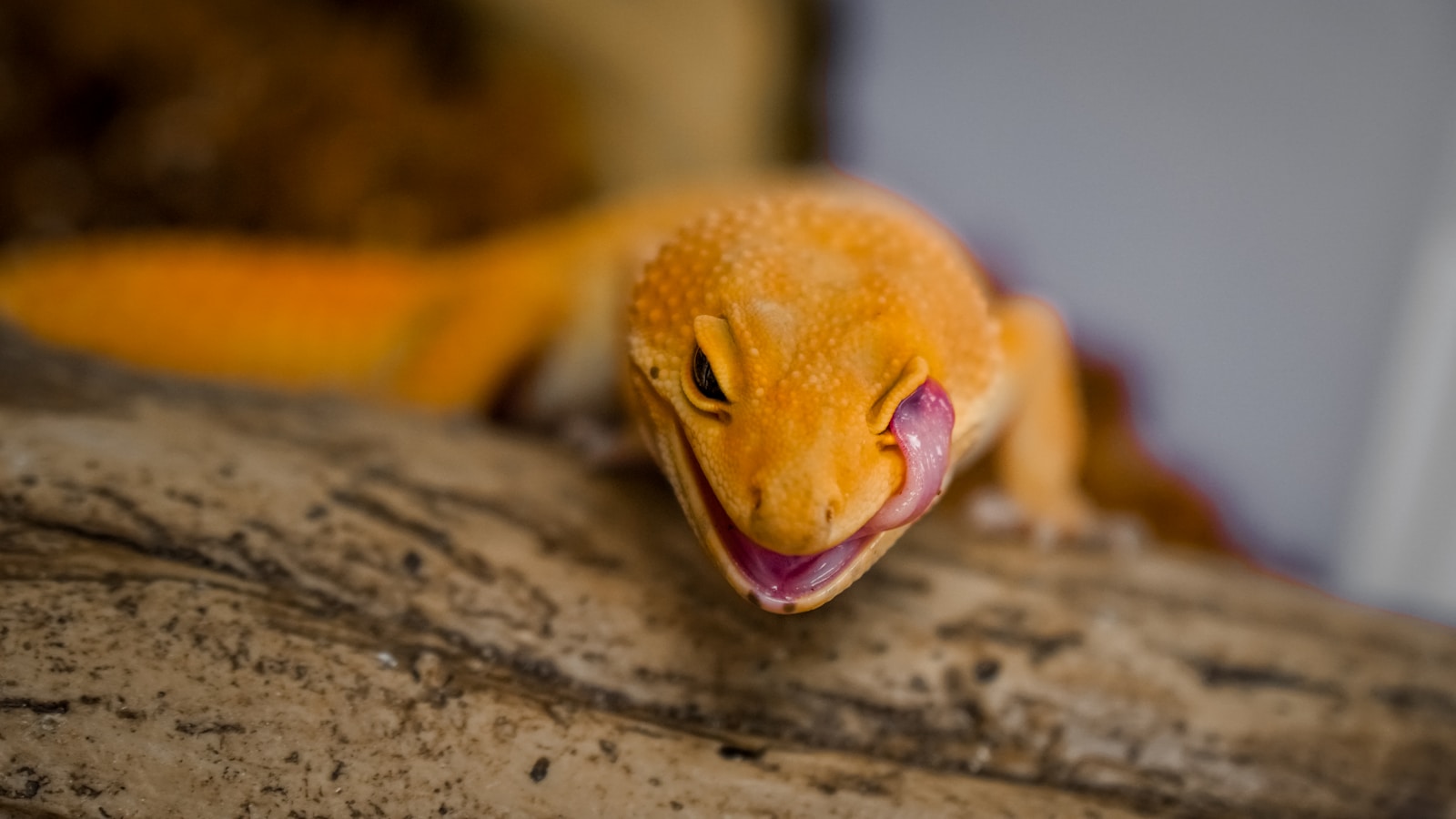


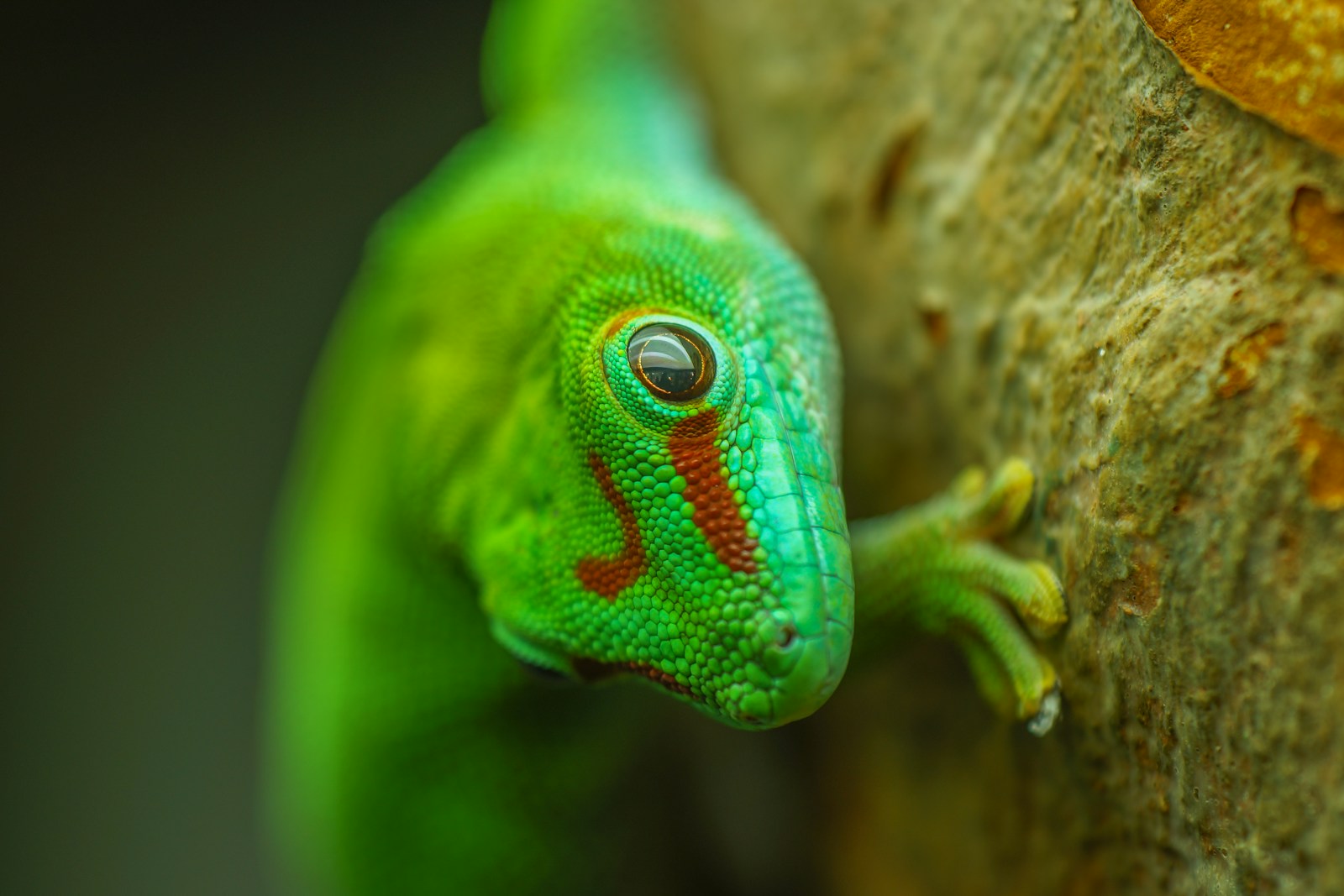
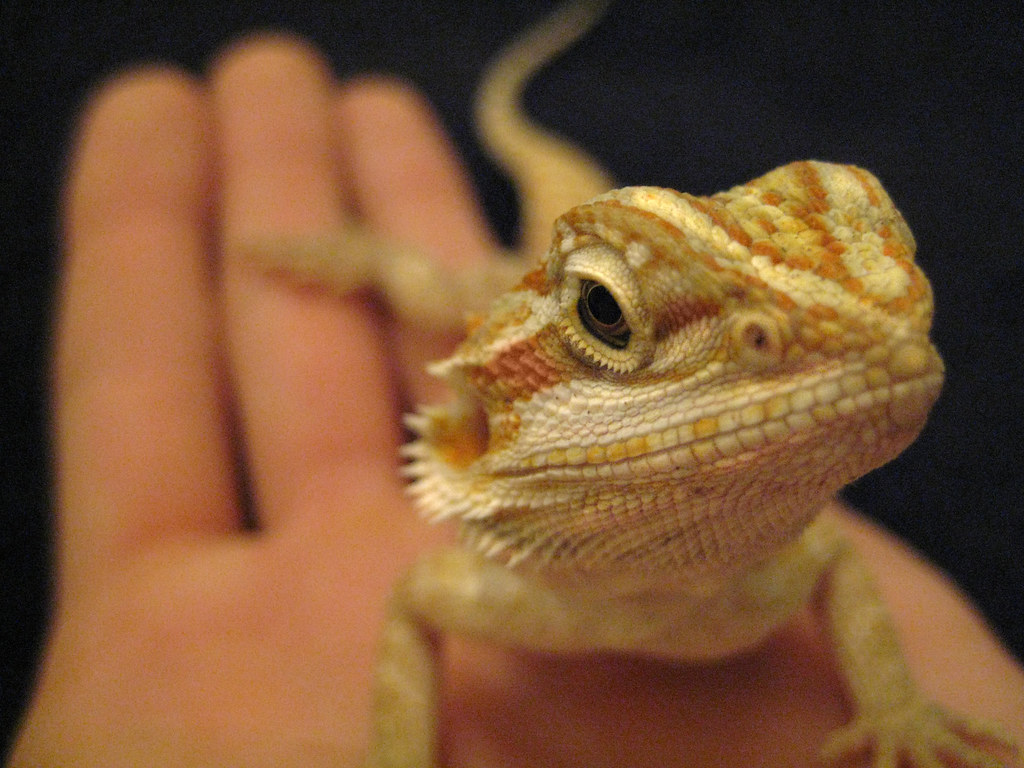

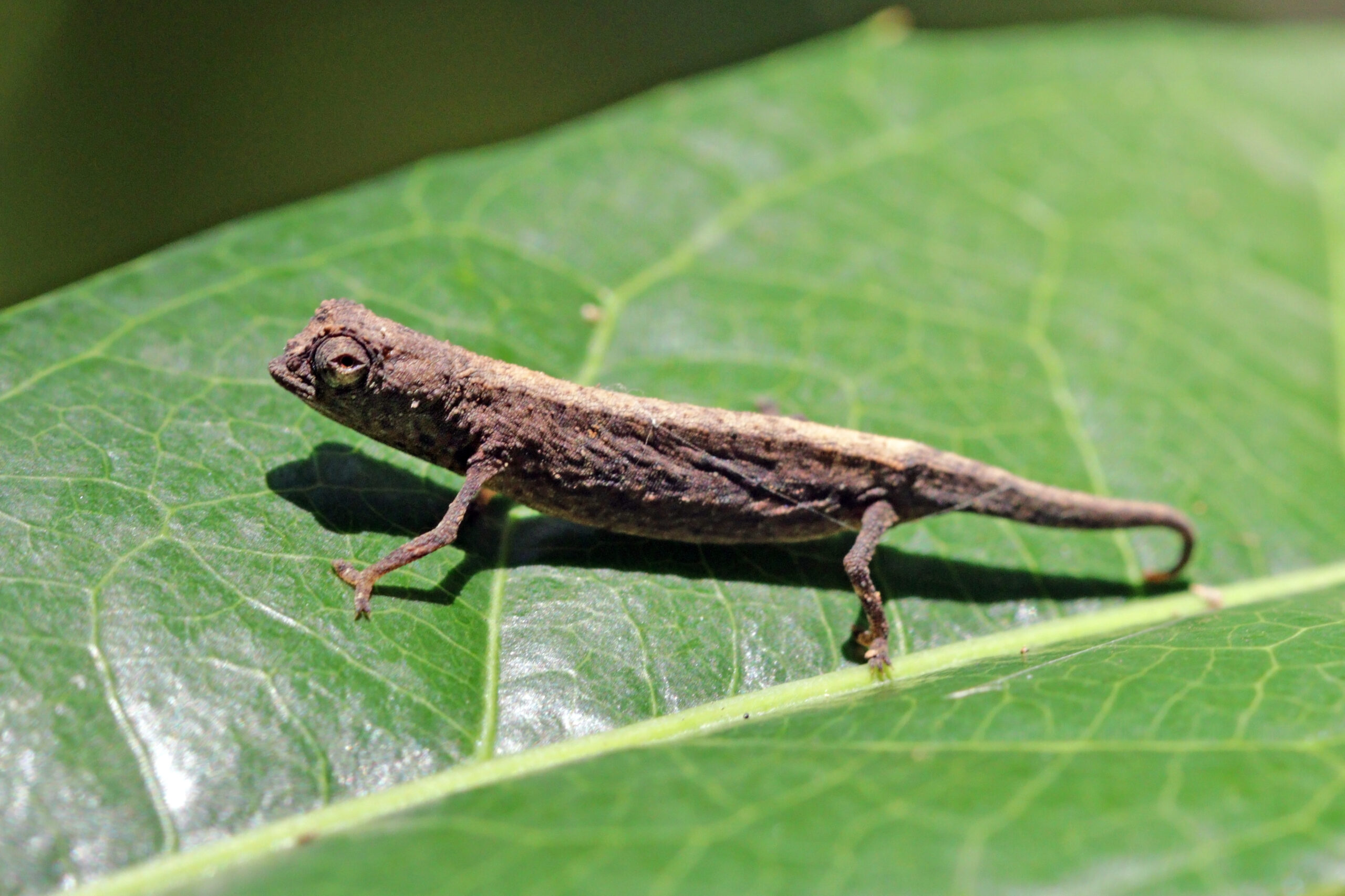

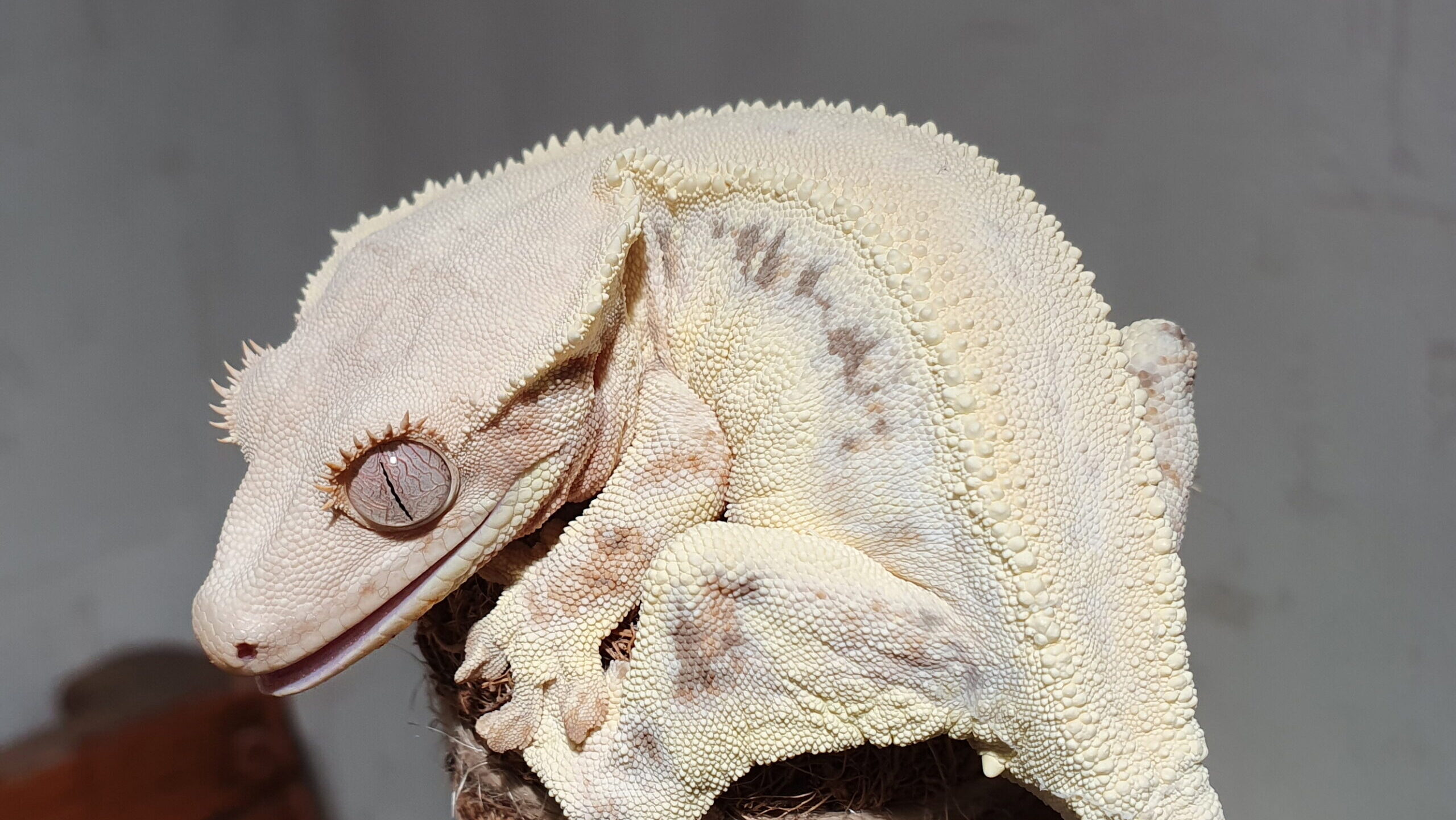
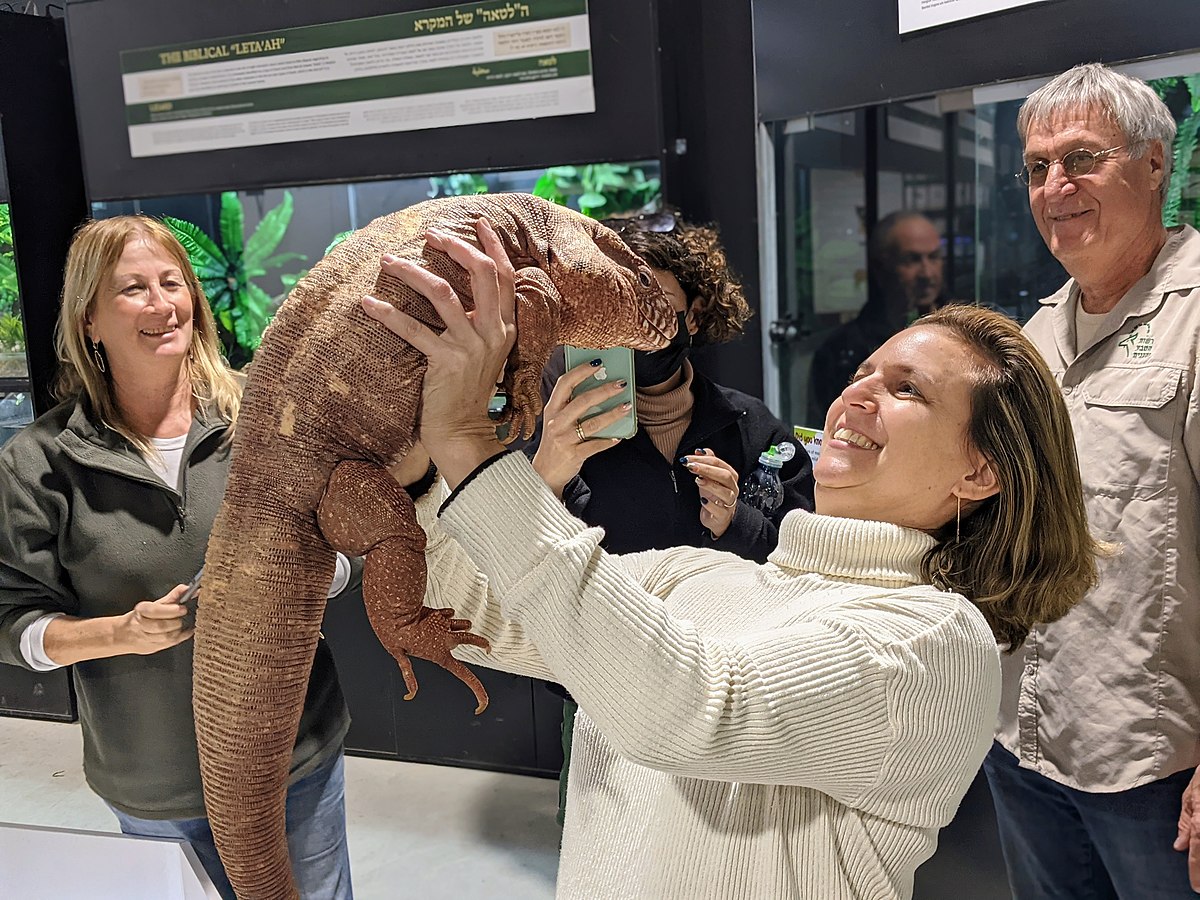





Leave a Reply